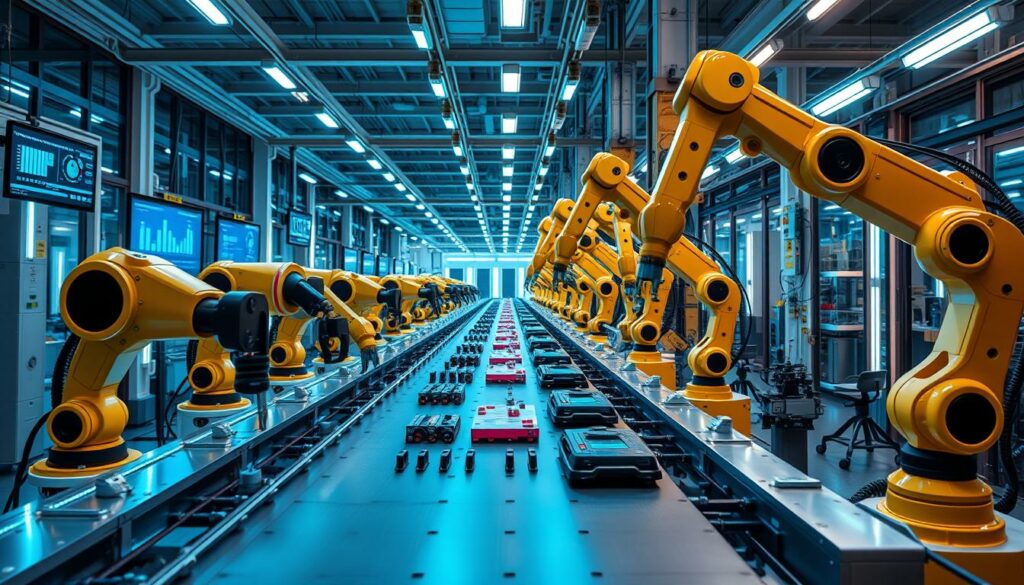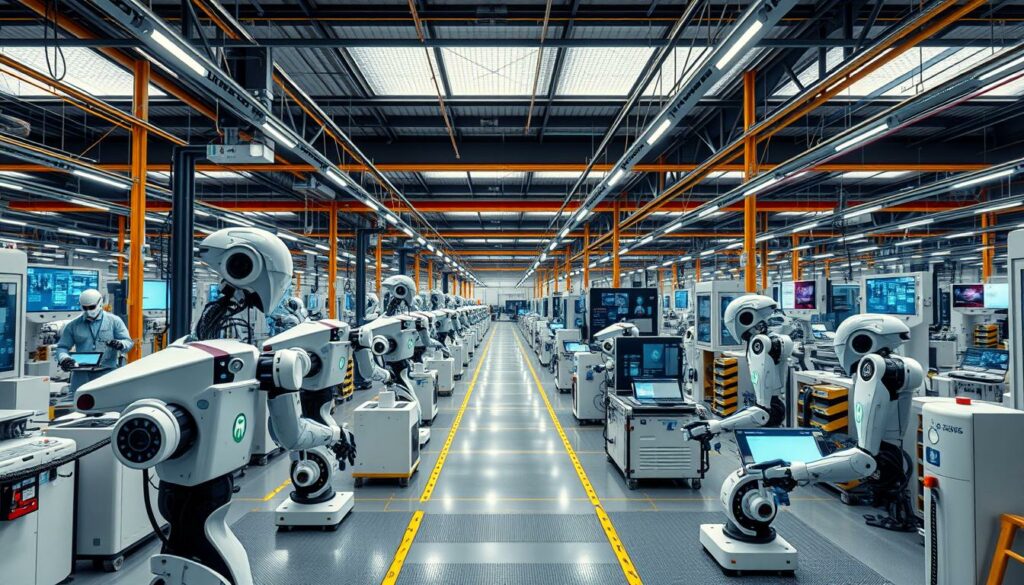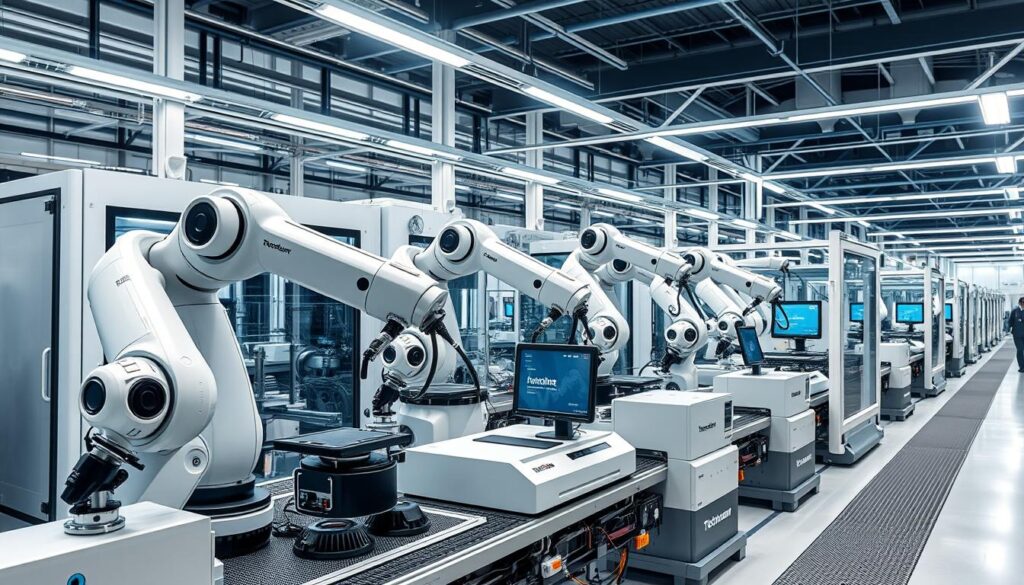Did you know that 82% of supply chain groups are focusing on logistics in 2024? This shows how big a deal robotics, especially Robotic Process Automation (RPA), is in making things. Now, robots are moving from simple tasks to complex ones like putting together parts, checking quality, and managing logistics.
This move to automation is changing how we make products. It makes processes smoother and more efficient. By adding robots to your work, you improve logistics and inventory management. You also cut down the time your workers spend on boring tasks. To get the most out of RPA, planning it well is key.
For more on the good and bad sides of RPA in logistics, check out APQC. They offer insights and data on how RPA works in different industries.
Key Takeaways
- Robotics is changing many manufacturing steps, not just simple ones.
- RPA makes things more efficient by cutting down on logistics and inventory work.
- 82% of companies are focusing on logistics, showing a big trend in the industry.
- Planning well when you add RPA is important for getting the best results.
- Knowing the challenges of RPA can help companies switch over better.
The Rise of Robotics in Manufacturing
Robotics is changing the game in manufacturing, making companies work smarter. These machines can do tasks on their own or with a little help. They make things run smoother and more precisely than humans can.
Knowing about robotics in manufacturing is key today. It’s a big deal and getting bigger.
Defining Robotics and Its Role
Robotics means using machines that work by themselves or with a bit of help. They help make things faster and use less human effort. These machines can do many jobs, like putting parts together or checking quality.
As robotics gets better, it helps businesses automate more tasks. It’s important to keep up with this change to stay ahead.
Statistics on Robotics Adoption
More and more companies are using robots in manufacturing. Now, over 2.7 million industrial robots are working hard around the world. This shows a big growth in using robots.
Most companies in manufacturing are focusing on logistics for 2024. This means they want to use robots to make things run smoother. Already, 24% of companies are using robots for logistics tasks.
The consumer products industry is leading with 42% of companies using robots for logistics. This shows a big move towards automating these tasks.
About 70% of companies using robots in logistics say they’re doing better. They have fewer mistakes and less rework. Even though cost is a big concern, many are still interested in using automation.
These stats are important for businesses thinking about using robots. The world of robotics is changing how manufacturing works.
If you’re into tech trends and privacy policies, check out this relevant resource.
Benefits of Robotics in Manufacturing
Robotics has changed how manufacturing works. It makes things run smoother and faster. Companies use robots to do tasks better and make more products.
By using robots, companies can make more and make fewer mistakes. This helps them stay ahead in a fast-changing market.
Enhanced Efficiency and Productivity
Robotics is key to making manufacturing better. Robots work non-stop and do tasks faster than people. This means more work gets done quickly.
Using robots well means your business can make the most of its resources. This leads to more work done with less downtime.
Cost Reduction through Automation
Using robots can save money for companies. It cuts down on labor costs and makes processes smoother. This means companies can use their money better.
Robots also make fewer mistakes, which saves money. Many companies see big savings and make more money. Using automation helps businesses grow over time.
| Benefit | Impact |
|---|---|
| Improved Efficiency | Higher output and reduced cycle time |
| Increased Productivity | Continuous operation without fatigue |
| Cost Reduction | Lower labor expenses and minimized errors |
| Resource Optimization | Enhanced allocation of resources for growth |
How Robotics Improves Quality Control
Adding robotics to the manufacturing process brings big changes to quality control. It makes production more precise at every step. Automated systems check products better than humans, making sure they meet high standards.
Precision in Manufacturing Process
Robotics brings unmatched precision to making things. Robots with advanced sensors spot flaws humans might miss. This means products are made with less variation in quality.
Automated machines check products as they’re made, keeping quality the same in every batch. This lets manufacturers send out top-quality products.
Reduction of Human Error
Using robotics in quality control cuts down human mistakes by up to 50%. By doing routine checks automatically, companies avoid the errors of manual processes. This leads to better quality and happier customers.
For more on new ways to improve quality control, check out innovative manufacturing methods that support advanced applications.
| Aspect | Manual Inspection | Robotic Inspection |
|---|---|---|
| Precision Level | Variable | High |
| Error Rate | Higher | Lower |
| Real-time Evaluation | No | Yes |
| Consistency Across Batches | Variable | Consistent |
Challenges in Implementing Robotics
Adding robotics to manufacturing comes with big hurdles. The high cost of starting can stop many companies. These systems need a lot of money, especially for small businesses. It’s key to know these costs before you start.
Initial Investment Costs
Robotics can be expensive upfront. You have to buy the gear and change your old systems to fit the new tech. Many companies find it hard to weigh the costs against the benefits. This makes them think twice about using robotics, even though it can make things more efficient.
Training and Skill Gaps in Workforce
There’s also a big challenge with the skills of your workers. As tech gets better, your team might not know how to work with robots. It’s important to train them well. You’ll need big training programs to make sure they can use and keep the robots running right. The gap between what skills you need and what your workers have can slow things down.
| Challenges | Description |
|---|---|
| Initial Investment Costs | High upfront costs for equipment and retrofitting existing systems. |
| Training Requirements | The need for extensive training programs to upskill employees. |
| Skill Gaps | Existing workforce may lack necessary skills to operate new technologies. |
| Long-term Planning | Organizations must plan carefully to maximize the benefits of robotics. |
Knowing about the high costs and the need for training can help you overcome the challenges of adding robotics to manufacturing. Facing these issues early on can make the switch smoother and boost your productivity.
Robotics and Supply Chain Management
Robotics is changing how we manage supply chains. It makes logistics and inventory management better. By using robots, businesses can do things faster and more accurately.
Streamlining Logistics with Robotics
Robotics makes logistics better by doing repetitive tasks automatically. This leads to quicker and more precise work. Using robotic process automation (RPA) is a big step forward.
Companies that use robotics see more work done and better quality. Studies show that about 70% of companies that use RPA see better quality as a big plus.
The Future of Inventory Management
Robotic solutions will change inventory management a lot in the future. They help track inventory in real-time, keeping stock levels right. This means fewer mistakes.
Looking forward, companies that use robotics for inventory will see big gains in efficiency and accuracy. Planning for RPA is key to getting the most out of it. Reports say 82% of companies are putting more money into logistics in 2024.
| Industry | Adoption Rate of RPA in Logistics |
|---|---|
| Consumer Products/Packed Goods | 42% |
| Petroleum/Chemical | 7% |
Getting the most from robotics needs good planning and teamwork. Learning from others who have done it well can help. To learn more about the good and bad of robotic process automation in logistics, visit this resource.
Robotic Process Automation (RPA) in Manufacturing
Robotic Process Automation (RPA) is changing the game in manufacturing. It automates tasks that are repetitive and boring. By using software robots, it improves how workflows, data, and reports are handled. This leads to big gains in how things get done.
Knowing how RPA works helps companies make their logistics better and boost productivity.
Understanding RPA and Its Applications
In manufacturing, RPA offers big benefits, especially in managing logistics and inventory. Many companies use RPA to get tasks done fast with less human help. The consumer products and packaged goods industry is a big user of RPA at 42%.
With 66% of companies likely to use RPA soon, it’s becoming key in modern manufacturing.
Benefits and Barriers of RPA
RPA brings many advantages, like better quality in operations, as seen by 70% of users. It saves time on repetitive tasks or lowers risks, which over half of manufacturers have noticed. But, there are challenges, like high costs, which are a big issue for many.
To fully benefit from RPA, companies need to work on improving processes and build a strong tech base.
Logistics is a big focus for 82% of manufacturers, showing a strong interest in using RPA to manage inventory better. For more details, check out this in-depth article on how companies use RPA in logistics and its pros and cons.
| Industry | RPA Adoption Rate | Prioritization of Logistics |
|---|---|---|
| Consumer Products/Packed Goods | 42% | High |
| Petroleum/Chemical | 7% | Low |
| Overall Manufacturing | 24% | 82% prioritize logistics investment |

Case Studies of Robotics in Action
Robotics has changed how industries make things. By looking at real examples, we see how it’s made things better. We learn from leaders in the field.
Successful Implementations in Various Industries
Big names in the automotive and electronics sectors have used robotics well. Companies like Ford and GM use robots to make cars faster and cheaper. Samsung uses robots to make tiny electronics with great precision.
These examples show how robotics can change things in many ways. It’s not just for one type of industry.
Learning from Industry Leaders
Looking at what leaders do with robotics teaches us a lot. Here are some key lessons:
- Understanding Workflow: Knowing how things work before adding robots helps make the change smoother.
- Continuous Training: Training workers helps them work well with robots.
- Incremental Integration: Adding robots step by step lets companies see how it goes and adjust as needed.
These stories show how robotics has made a big difference. They help us see how it can shape the future of making things.
Future Trends in Robotics for Manufacturing
The manufacturing world is changing fast, thanks to AI and new tech. These changes are making robotics better for the industry. They’re leading to a smarter and more efficient future.
Integration of AI and Robotics
AI is changing the game in robotics. It lets machines do complex tasks better and adapt more easily. With AI, smart robots can learn and improve on their own. This makes production more efficient and changes how we work in manufacturing.
Advancements in Robotics Technology
Cobots, or collaborative robots, are a big deal in manufacturing. They work with people safely and boost productivity. In the next few years, we’ll see even more improvements in robots. By 2028, the robotics market could grow by 25% a year, thanks to AI.
Companies are looking into robotic process automation for logistics. They want to make inventory management better and more efficient.

| Trend | Description | Expected Impact |
|---|---|---|
| AI Integration | Combining AI with robotics for smarter operations | Increased adaptability and efficiency in tasks |
| Collaborative Robots | Cobots working alongside human operators safely | Enhanced productivity and worker safety |
| Market Growth | Global robotics market projected to grow by 25% annually by 2028 | Broader adoption of robotics across industries |
Conclusion
Robotics is changing the manufacturing world, bringing new levels of efficiency and innovation. Companies are putting more money into tech like robotics and generative AI. This looks very promising for the future of manufacturing.
Investing in robotics means better quality control and lower costs. But, there are challenges like high upfront costs and needing skilled workers. Still, robotics is growing as companies see its value.
AICA’s tech is up to 90% faster than old methods for managing data. This shows how technology can boost performance. For more on generative AI in supply chains, check out this report.
Companies are now creating new jobs for AI experts and updating how they handle data. It’s crucial to adopt these tech advances to stay ahead. Robotics and AI are key to keeping a competitive edge and growing sustainably in manufacturing.
FAQ
What is robotics in the manufacturing industry?
Robotics in manufacturing means using machines that can do tasks on their own or with some help. These machines make things faster and work better.
How has the adoption of robotics changed in recent years?
More and more robots are being used, with over 2.7 million in use worldwide. This is a 10% increase from last year. It shows more companies are using automation.
What are the key benefits of using robotics in manufacturing?
Robots work all the time without getting tired. This means they make things faster and cheaper. They also make sure products are made just right.
How do robots contribute to quality control in manufacturing?
Robots check products at every step of making them. They use special sensors to find any problems. This cuts down on mistakes by up to 50%.
What challenges do companies face when implementing robotics?
Companies face big costs to start using robots. They also need to train workers because not everyone knows how to work with them.
In what ways do robotics streamline supply chain management?
Robots make handling and tracking materials better. This means things move faster and there are fewer mistakes.
What is Robotic Process Automation (RPA) and how does it apply to manufacturing?
RPA uses software robots to do tasks like managing work and processing data. It makes things run smoother but can be hard to set up and some workers might not like it.
Can you provide examples of successful robotics implementation in industry?
Companies like Ford and General Motors use robots to make cars faster and cheaper. Samsung uses them to make electronics more accurately.
What future trends are emerging in robotics for manufacturing?
The future looks bright with robots getting smarter thanks to Artificial Intelligence. These smart robots can learn and change, which could grow the robotics market by 25% each year by 2028.
Source Links
- https://www.scmr.com/article/rpa-benefits-and-barriers
- https://www.intelligentliving.co/12-pillar-candle-set-themes-2024/
- https://www.scmr.com/article/the-benefits-and-challenges-of-rpa-in-logistics
- https://www.prnewswire.com/news-releases/bd-completes-acquisition-of-critical-care-from-edwards-lifesciences-302237204.html
- https://www.engineering.com/3d-printing-techniques-join-wood-and-metal-without-adhesives/
- https://www.scmr.com/article/synchronizing-supply-chain-planning-execution-analytics/procurement
- https://www.giantfreakinrobot.com/ent/monster-true-crime-new-season.html
- https://www.aol.com/mayim-bialik-opens-her-latest-195914071.html
- https://mashable.com/article/beetlejuice-beetlejuice-review
- https://usccg.com/?post_type=post&p=8984
- https://medium.com/majordigest/defense-intel-teams-monitor-earth-and-space-with-broad-area-management-a519a4c291e0
- My Guide to Understanding Data Centre Architecture: Core Components Every IT Pro Should Know
- Wazuh Home Network Setup: A Step-by-Step Guide
- Quantum Computers Decrypting Blockchain: The Risks and Implications
- Wazuh: Enterprise-Grade Security for Your Business
- Wazuh for Beginners: A Comprehensive Guide
Related posts:
 AI-Powered Robots: The Next Step in Automation
AI-Powered Robots: The Next Step in Automation
 How to Use Digital Twins for Predictive Maintenance in 2024
How to Use Digital Twins for Predictive Maintenance in 2024
 AI and Robotics: How They Work Together in Automation
AI and Robotics: How They Work Together in Automation
 Big Data Analytics Trends and Applications in Industry
Big Data Analytics Trends and Applications in Industry
 How Quantum Sensors are Changing the Face of Medicine
How Quantum Sensors are Changing the Face of Medicine
 How to Secure Data Using Quantum Encryption
How to Secure Data Using Quantum Encryption
